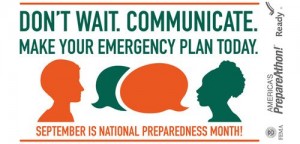
Do You Have a Plan?
 The Montgomery County Office of Emergency Management and Homeland Security (OEMHS) is reminding residents that September is National Preparedness Month. Every year, emergencies affect millions of people globally, causing injuries, fatalities, economic losses and emotional stress. However, simple emergency planning and preparedness can greatly decrease losses.
The Montgomery County Office of Emergency Management and Homeland Security (OEMHS) is reminding residents that September is National Preparedness Month. Every year, emergencies affect millions of people globally, causing injuries, fatalities, economic losses and emotional stress. However, simple emergency planning and preparedness can greatly decrease losses.
This year’s theme, “Don’t Wait. Communicate. Make Your Emergency Plan Today,” emphasizes taking action now to be prepared for eventual emergencies. Planning strategies should be in place for family and pets, as well as the workplace and the greater community.
The following is an easy-to-follow planning guideline:
1. Stay Informed: Know what kind of hazards you’re susceptible to, and how to get information about emergencies that are occurring in the area. Montgomery County has Alert Montgomery, which sends emails and texts to cell phones so that you can be informed about severe weather, traffic disruptions, power outages, and floods, among other events. Sign up for Alert Montgomery here.
2. Make a plan: Take some time to figure out how to reach family members in times of disaster. Have an in-town contact, as well as an out-of-town contact. Know the cell phone numbers for your contacts. You may need to text message contacts if phone lines become overloaded in the affected area. Also have two places to meet family members and loved ones in case of the need to evacuate. One outside the home in a safe location, and one outside the neighborhood in case you cannot return home. Be sure any plan has considerations for children, older adults, pets, and those with access and functional needs, if needed. More information about making a plan can be found here.
3. Make a Kit: Think about what will be needed for basic survival, and make an emergency supply kit to have readily available in case of the need to evacuate or shelter in place. Items in the kit should contain: water, batteries, flashlight, food, clothes and shoes, can opener, hygiene products and medication, among other items. For a more complete list, click here.
4. Get Involved: Finally, help others to be prepared, once you have your items and plan ready. Contact older relatives, neighbors and friends to assist them in getting prepared; also check on them after an event. Support neighborhood associations that are involved in emergency response, or better yet, join an emergency volunteer association, or get training on CPR and first aid. Information about some of these groups can be found here.
The information above and more can be found on the OEMHS website: http://www.montgomerycountymd.gov/oemhs/.


Engage us on Facebook
Follow us on Twitter
Tweets by @mymcmedia